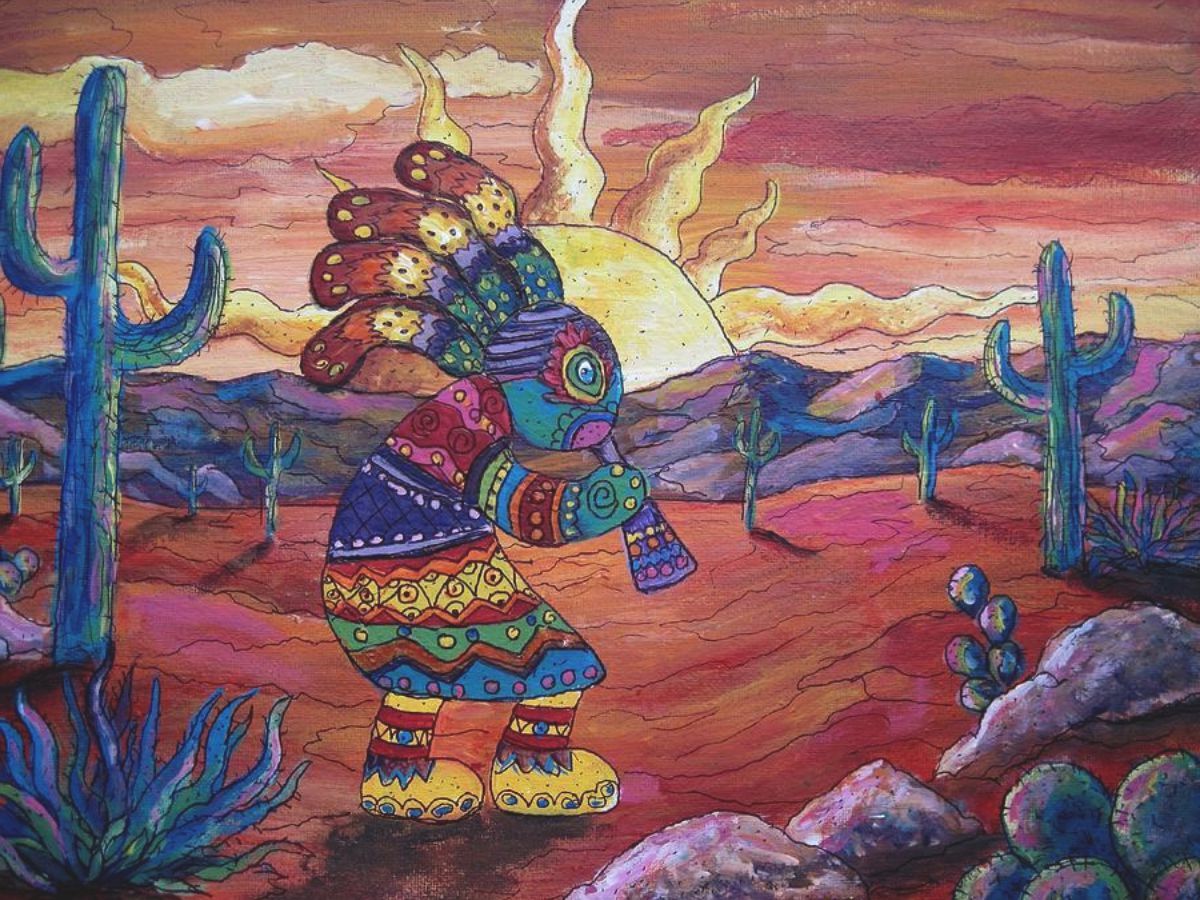
Who is Kokopelli? Kokopelli is a legendary figure from Native American folklore, often depicted as a humpbacked flute player. This iconic character symbolizes fertility, joy, and music. Why is Kokopelli important? Kokopelli holds a significant place in the traditions of Southwestern tribes, including the Hopi and Zuni. He is believed to bring good harvests, healthy babies, and prosperity. What does Kokopelli represent? Beyond fertility, Kokopelli embodies the spirit of celebration and storytelling. His image can be found in ancient rock art, pottery, and modern-day crafts. Why is Kokopelli still relevant today? Kokopelli's enduring legacy continues to inspire artists, musicians, and cultural enthusiasts. His playful and mysterious nature captivates people, making him a timeless symbol of joy and creativity.
Key Takeaways:
- Kokopelli, a playful fertility deity, brings joy and good harvests. His enduring presence in art, culture, and music showcases the lasting impact of Native American traditions.
- Kokopelli's mischievous nature and magical flute have inspired literature, music, and modern culture. His legacy symbolizes resilience, creativity, and the interconnectedness of life.
Who is Kokopelli?
Kokopelli is a fascinating figure from Native American mythology. Known for his distinctive hunchback and flute, Kokopelli is a symbol of fertility, joy, and music. Let's dive into some intriguing facts about this iconic character.
-
Kokopelli is a fertility deity. He is often associated with childbirth and agriculture, believed to bring good harvests and healthy babies.
-
The name "Kokopelli" comes from the Hopi language. It combines "koko," meaning wood, and "pelli," meaning hump.
-
Kokopelli is often depicted as a hunchbacked flute player. This image is one of the most recognizable symbols in Southwestern Native American art.
-
He is considered a trickster god. Much like Loki in Norse mythology, Kokopelli is known for his playful and mischievous nature.
-
Kokopelli is a symbol of music and dance. His flute playing is said to bring joy and happiness to those who hear it.
Kokopelli in Art and Culture
Kokopelli's influence extends beyond mythology into various forms of art and culture. His image can be found in numerous places, each telling a different story.
-
Kokopelli appears in ancient petroglyphs. These rock carvings date back over a thousand years and can be found throughout the American Southwest.
-
Modern artists often use Kokopelli in their work. His image is popular in jewelry, pottery, and textiles.
-
Kokopelli is a popular motif in Southwestern decor. Many homes and businesses in the region feature his likeness.
-
He is also a symbol of the American Southwest. Kokopelli represents the unique cultural heritage of this region.
-
Kokopelli is featured in many festivals and celebrations. These events often include music, dance, and storytelling.
Kokopelli's Role in Native American Tribes
Different tribes have their own interpretations and stories about Kokopelli. His role can vary significantly from one tribe to another.
-
The Hopi see Kokopelli as a rainmaker. He is believed to bring rain and ensure a bountiful harvest.
-
For the Zuni, Kokopelli is a trader. He travels from village to village, bringing goods and news.
-
The Navajo associate Kokopelli with fertility. They believe he can help women conceive and ensure healthy pregnancies.
-
Kokopelli is a central figure in many Pueblo stories. These tales often highlight his mischievous and playful nature.
-
Some tribes believe Kokopelli can heal. His flute playing is said to have the power to cure illnesses.
Kokopelli in Modern Times
Kokopelli's influence continues to grow, even in contemporary society. His image and stories have found new life in various modern contexts.
-
Kokopelli is a popular tattoo design. Many people choose his image for its cultural significance and unique appearance.
-
He appears in various forms of media. Kokopelli has been featured in books, movies, and video games.
-
Kokopelli is a mascot for some sports teams. His playful and energetic nature makes him a fitting symbol.
-
He is used in branding and marketing. Companies often use Kokopelli's image to evoke a sense of fun and tradition.
-
Kokopelli is a symbol of resilience. His enduring presence in culture shows the lasting impact of Native American traditions.
Fun Facts About Kokopelli
Here are some lighter, fun facts about Kokopelli that showcase his whimsical side.
-
Kokopelli is sometimes depicted with a female counterpart. Known as Kokopelli Mana, she shares many of his traits.
-
He is often shown with animals. Birds, insects, and other creatures are frequently included in his depictions.
-
Kokopelli's flute is said to have magical powers. It can bring rain, heal the sick, and even make people fall in love.
-
Some legends say Kokopelli can shape-shift. He can transform into animals or other beings to play tricks on people.
-
Kokopelli is a popular figure in children's stories. His playful nature makes him a favorite among young audiences.
Kokopelli's Influence on Music
Given his association with the flute, it's no surprise that Kokopelli has had a significant impact on music.
-
Many musicians draw inspiration from Kokopelli. His image and stories often influence their work.
-
Kokopelli is featured in various musical compositions. Some pieces are specifically written to honor him.
-
He is a symbol of musical creativity. Kokopelli represents the joy and freedom that music can bring.
-
Kokopelli's flute is a popular instrument. Many people learn to play the flute because of his influence.
-
Music festivals often feature Kokopelli. His image is used to promote events that celebrate music and culture.
Kokopelli in Literature
Kokopelli's stories and symbolism have also found their way into literature, enriching the narratives of many authors.
-
Kokopelli appears in numerous books. Both fiction and non-fiction works explore his mythology.
-
He is a character in many Native American legends. These stories are passed down through generations.
-
Kokopelli is a symbol of storytelling. His tales are a testament to the power of oral tradition.
-
Authors use Kokopelli to explore themes of fertility and creativity. His image adds depth to their narratives.
-
Kokopelli's stories often include moral lessons. They teach values like kindness, generosity, and resilience.
Kokopelli's Enduring Legacy
Kokopelli's legacy continues to thrive, influencing various aspects of culture and society.
-
Kokopelli is a symbol of cultural preservation. His enduring presence helps keep Native American traditions alive.
-
He represents the interconnectedness of life. Kokopelli's stories remind us of the importance of community and nature.
Kokopelli: A Timeless Symbol
Kokopelli, with his mysterious origins and rich symbolism, continues to captivate people today. This humpbacked flute player isn't just a figure from ancient rock art; he's a cultural icon representing fertility, music, and joy. Found in various forms across the Southwestern United States, Kokopelli's image has been adapted into modern art, jewelry, and even tattoos. His presence in Native American legends and ceremonies highlights his importance in indigenous cultures. Whether you're drawn to his playful spirit or his deep cultural significance, Kokopelli remains a timeless symbol that bridges the past and present. Understanding Kokopelli offers a glimpse into the rich tapestry of Native American heritage and the enduring power of myth and legend. So next time you see this iconic figure, remember the stories and meanings he carries with him.
Frequently Asked Questions
Was this page helpful?
Our commitment to delivering trustworthy and engaging content is at the heart of what we do. Each fact on our site is contributed by real users like you, bringing a wealth of diverse insights and information. To ensure the highest standards of accuracy and reliability, our dedicated editors meticulously review each submission. This process guarantees that the facts we share are not only fascinating but also credible. Trust in our commitment to quality and authenticity as you explore and learn with us.


